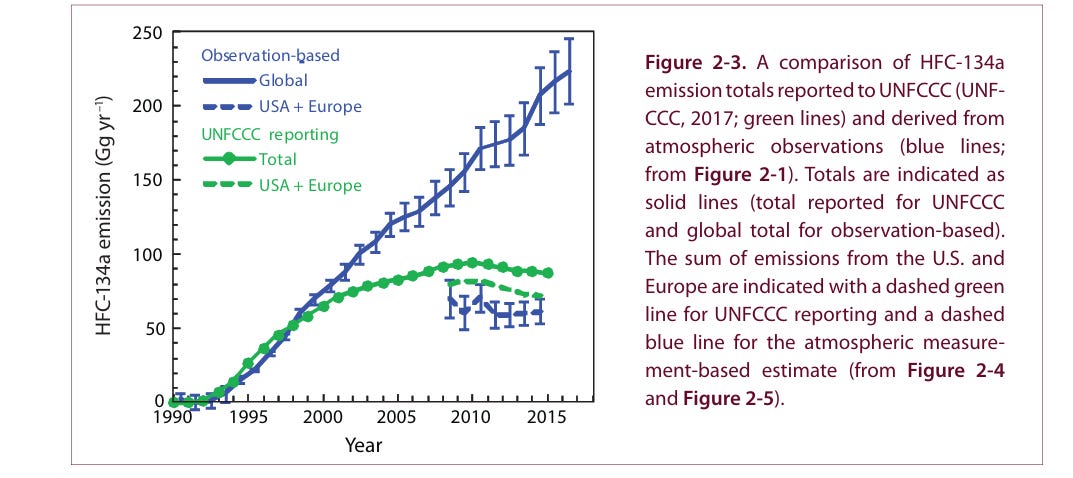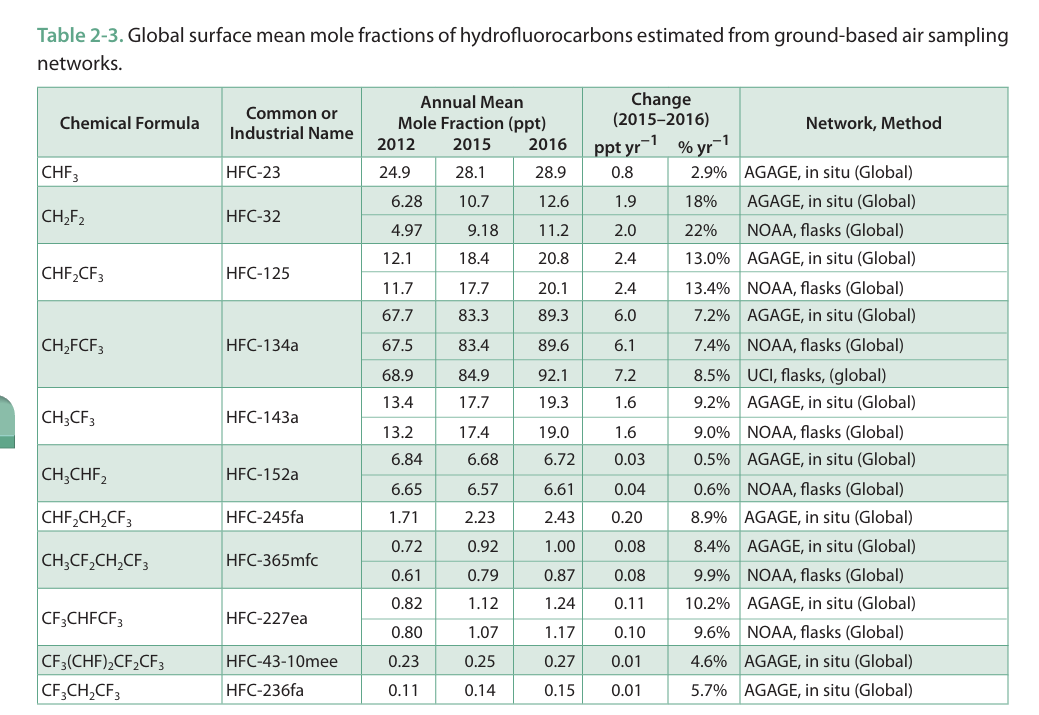I am almost sure you have never heard of HFC or hydrofluorocarbon before:
any of several organic compounds composed of hydrogen, fluorine, and carbon. HFCs are produced synthetically and are used primarily as refrigerants. (Brittanica)
On average, these molecules have 3770 times more impact on the warming of our planet than CO2!
Within the troposphere, the carbon-fluorine bonds in HFCs are highly effective at trapping solar radiation (specifically, infrared radiation) and redirecting that radiant energy toward Earth’s surface. This so-called positive radiative forcing effect contributes to global warming.
When did we begin emitting this into our atmosphere? When did you first notice global warming? I first noticed it in 1995 during the winter, but it became more pronounced in 2010 during the summer, about 20 years after we started using HFC.
In the 1990s, we started using these compounds for the first time. Some compounds increased from 0 to 50 today; the average lifespan of these molecules is 14 to 30 years, which is 5 times shorter than the lifespan of compounds used in refrigerators, like CFCs that have been damaging the ozone layer, but 3770 times worse than CO2 (Britannica).
The absorptive efficiency of a single HFC molecule is many thousands of times greater than that of carbon dioxide (CO2). Therefore, even very small amounts of these gases emitted to the atmosphere can make large contributions to the total radiative forcing of the climate system and thus produce long-lasting effects on the radiative energy balance of the earth-atmosphere and global climate change (link)
It appears to be a tradeoff for lunatics: 3770 for 5?
The rise has been exponential (blue line), with annual rates reaching up to 20% for some compounds, but averaging close to 10%, which means we are now 100% higher than in 2016 (as shown by the example of HFC-125 below); the compound with the 270 years lifetime, HFC-23, has global warming potential of 11,000 times that of CO2.
You still think you will find logic among evil? The definition of evil is a lack of logic or foolishness.
Most HFCs that are emitted to the atmosphere are intentionally produced for use in a variety of applications that were once dependent on ODSs (ozone damaging substances). An exception is HFC-23, which is emitted to the atmosphere primarily as a by-prod uct of HCFC-22 production. HFC-23 is also unique in that it has a substantially longer atmospheric lifetime and higher GWP(global warming potential) than nearly all other HFCs
No, it's not China; rather, it's the scientific community in the developed world that endorses these emissions while lecturing you about your CO2 footprint.
The dramatic increase in this emission gap over time is consistent with substantial increases in HFC use in developing countries not obligated to report emissions to the UNFCCC, as had been projected (Velders et al., 2009, 2015; Gschrey et al., 2011).
Where are these compounds most commonly used?
In the publication Scientific Assessment of Ozone Depletion: 2018, we can read the following:
Hydrofluorocarbons have been used in refrigeration, air conditioning, thermal insulating foam, and mis cellaneous applications since the 1990s, replacing the CFCs and HCFCs that were traditionally used in these applications. The first widespread HFC use was of HFC-134a beginning in the early 1990s, as a substitute for CFC-12 in mobile air conditioning (Montzka et al., 1996; Oram et al., 1996; Andersen et al., 2013).
Within a decade most mobile air conditioners used this HFC (Papasavva et al., 2009), and this remains true today. With the global CFC phase-out in 2010 and the ongo ing HCFC phase-out, the use of HFCs has increased substantially, not only for various refrigeration and air conditioning applications, but also as foam blowing agents, as medical aerosols, and to a lesser extent as cleaning, etching, and fire-fighting agents. As was true for ODSs (ozone destroying substances), emissions of HFCs follow production and consumption with a delay of months to decades, de pending on the type of application in which the HFCs are used. HFCs do not contain ozone-depleting chlorine or bromine, but are potent greenhouse gases (Harris and Wuebbles et al., 2014)
The largest historical HFC use and emissions are in the developed countries, primarily the USA, EU, and Japan (Figure 2-16).
In the baseline scenario, China is projected to become the largest emitter of HFCs by 2020, and Chinese emissions are projected to reach 31% of total CO2-eq emissions (100-yr time horizon) of all HFCs by 2050 in the upper range HFC scenario (Velders et al., 2015). In all countries or regions, the largest contributions in CO2-eq emissions come from industrial and commercial refrigeration (range of 40–58% for the different regions by 2050), because of the large use of HFCs and relatively large leakage rates from these applications, while the second largest HFC source comes from stationary air conditioning (AC) (21–40% by 2050) (Figure 2-16).
CONCLUSION
Do you need more evidence that it is a deliberate and conscious poisoning of the Earth with substances that act as a blanket, keeping us very warm?
You've been sold a story about buying electric cars, but how often do you need to recharge your car's air conditioning? No, it is not CO2, but your air conditioning systems that have been warming us up exponentially since the 2000s.
It is not the lack of knowledge but the love of lies that makes us slaves of the serpent. Foolish virgins will not enter paradise. The hallmark of being foolish is trusting people over numbers and facts, and not the Bible.
You think people who lied to you about the Moon will care for your well-being on Earth?
Even when Newton and all the evidence agree with the Bible:
3 Like the heavens in height and the earth in depth,
the heart of a king is unfathomable.[c]
Starting from Earth, if we use 99% of the escape velocity, we would only reach 310.000 km. The Moon is 385.000 km away, based on calculations from first-year high school mathematics.
I will end with HFC with a conclusion from a scientific paper from 2011 (the link is above) that talks about the future that has come:
This result indicates that HFCs will affect climate change significantly in the future.
The results show that the contributions of HFCs to future climate change are hundreds to thousands of times greater than the contributions of the same emission of CO2; thus HFCs will have a long-term impact on global warming.
If you still aren't convinced, take a moment to consider this – they are mocking us for our foolishness:










One more thing😉..that is also the way water is moved in storms to create floods.From the west coast to the east coast. pardon me please if I am duplicating your words.
Also-i think thats what creates what looks like vapor. Pardon me if that’s in your article I skimmed🙄